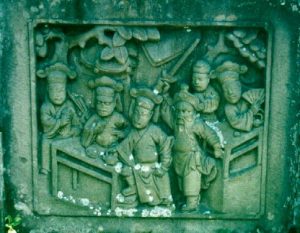
Guandoushan Stone Carving in Weixin County, Zhaotong

Attraction Overview
The existing 64 statues and more than 300 sets of relief sculptures of Guandoushan Stone Carving all present magnificent cultural, artistic, aesthetic and religious values, which are one of the representative works of modern Chinese stone carving art.
Chinese Name: 昭通威信县观斗山石雕(Pinyin: Guandoushan Shidiao)
Best Time to Visit: All-year-round
Recommended Visiting Time: Half Day
Altitude: 1880 meters
Location: Xinhua Village(新华村), Gaotian Township(高田乡), Weixin County of Zhaotong City of Yunnan Province
Where is Guandoushan Stone Carving – Location
Guandoushan Mountain is located at Xinhua Village(新华村), Gaotian Township(高田乡), Weixin County of Zhaotong city, the junction of Yunnan and Sichuan provinces. Back to Sichuan and facing Yunnan, it is 44 kilometers away from the Zaxi County(扎西县), adjacent to Gaofeng township(高峰乡) of Xuyong County(叙永县) in the east, Longshan Mountain(龙山) in the south, Luohanshan Mountain(罗汉山) in the west and Kunlunshan Mountain(昆仑山) in the north.
Features of Guandoushan Mountain
The main peak of Guandoushan mountain is 1880 meters above sea level. Due to warm and humid climate, with abundant rainfall and rich soil, the vegetation on the mountain is quite rich and diverse. In the spring, things come to life, flowers in green and birds singing, a scene of vitality; in the summer, lush trees and cool climate makes it an excellent place for summer heating; in the autumn, with the fragrance of wild, the mountain is covered with maple leaves and mountain ash leaves, as picturesque; in the winter, the white snow on the branches is like black dragon and white phoenix, quite interesting.
History and Culture

Guandoushan mountain is a famous religious mountain in eastern Yunnan and southern Sichuan. The temple on Guandoushan Mountain was built in the Ming dynasty, flourished in the Qing dynasty and the republic of China. In the Ming dynasty, centering on Guandoushan mountain, more than ten temples such as Kunlunshan temple, Xiaoxitian temple and Shensuolinshan were built. The temple was destroyed during the cultural revolution, only the ruins of Nine halls left. The first hall is Fozu Hall(佛祖殿), has the three stone statues of the thousand-handed Guanyin, Manjusri and Huochi Buddhas. The third hall has the stone statues of Queen Mother, the Eight Immortals, etc. In the fourth hall, there are the stone statues of Sakyamuni, Confucius and Lord Taishang. In the sixth hall, the Taoist gods and ancient mythological figures are enshrined, including Wuji, Nuwa, Pangu, Shennong, Xuanyuan, etc. The statues in the seventh hall, eighth hall and ninth halls are all stone carved.
The existing 64 statues and more than 300 sets of relief sculptures all present magnificent cultural, artistic, aesthetic and religious values, which are one of the representative works of modern Chinese stone carving art. In November 1985, it was listed as a key cultural relic protection unit at the county level by the people’s government of Weixin county. On May 4, 1988, it was announced by the people’s government of Yunnan province as the first scenic spots in Yunnan province. Guandoushan stone carving group was listed as a key cultural relic protection unit of Yunnan province in 1993.

 7 Days GolfingTour
7 Days GolfingTour
 8 Days Group Tour
8 Days Group Tour
 8 Days Yunnan Tour
8 Days Yunnan Tour
 7 Days Shangri La Hiking
7 Days Shangri La Hiking
 11 Days Yunnan Tour
11 Days Yunnan Tour
 6 Days Yuanyang Terraces
6 Days Yuanyang Terraces
 11 Days Yunnan Tour
11 Days Yunnan Tour
 8 Days South Yunnan
8 Days South Yunnan
 7 Days Tea Tour
7 Days Tea Tour
 8 Days Muslim Tour
8 Days Muslim Tour
 12 Days Self-Driving
12 Days Self-Driving
 4 Days Haba Climbing
4 Days Haba Climbing
 Tiger Leaping Gorge
Tiger Leaping Gorge
 Stone Forest
Stone Forest
 Yunnan-Tibet
Yunnan-Tibet
 Hani Rice Terraces
Hani Rice Terraces
 Kunming
Kunming
 Lijiang
Lijiang
 Shangri-la
Shangri-la
 Dali
Dali
 XishuangBanna
XishuangBanna
 Honghe
Honghe
 Kunming
Kunming
 Lijiang
Lijiang
 Shangri-la
Shangri-la
 Yuanyang Rice Terraces
Yuanyang Rice Terraces
 Nujiang
Nujiang
 XishuangBanna
XishuangBanna
 Spring City Golf
Spring City Golf
 Snow Mountain Golf
Snow Mountain Golf
 Stone Mountain Golf
Stone Mountain Golf


















